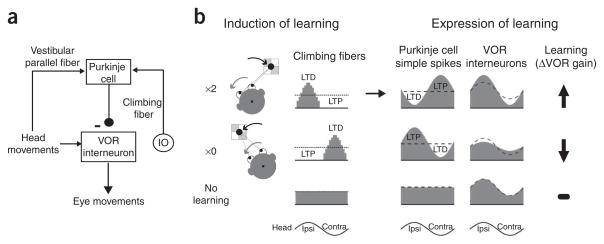Figure 1.
VOR circuit and Marr-Albus-Ito hypothesis for VOR learning. (a) VOR circuit. The climbing fiber input to the Purkinje cells originates from the inferior olive (IO), carries visual signals and is thought to control the induction of plasticity at the vestibular parallel fiber–Purkinje cell synapses. (b) Marr-Albus-Ito hypothesis. To induce VOR learning, we paired head movements with a visual stimulus that moves exactly opposite the head (×2) or with the head (×0), which drives climbing fiber responses with peak firing during ipsiversive (×2) or contraversive (×0) head movement, respectively. During training (induction of learning), increases in climbing fiber activity above baseline (dotted line) should induce LTD in the vestibular parallel fibers that are simultaneously active. During subsequent testing with head movements in total darkness (expression of learning), the LTD induced by ×2 training should alter Purkinje cell simple spike output during head movements so that this inhibition is more out-of-phase with the activity of the VOR interneurons, thereby increasing the response of the interneurons and the gain of the VOR (histograms, post-training responses; dashed traces, pre-training). In contrast, the LTD induced by ×0 training should cause Purkinje cells to fire more in-phase with VOR interneurons, thereby decreasing the VOR gain. The decrease in climbing fiber activity below baseline during the induction of learning may also induce LTP of parallel fibers firing during the corresponding phase of head movement, which would complement the effects of LTD on interneuron response amplitude.

